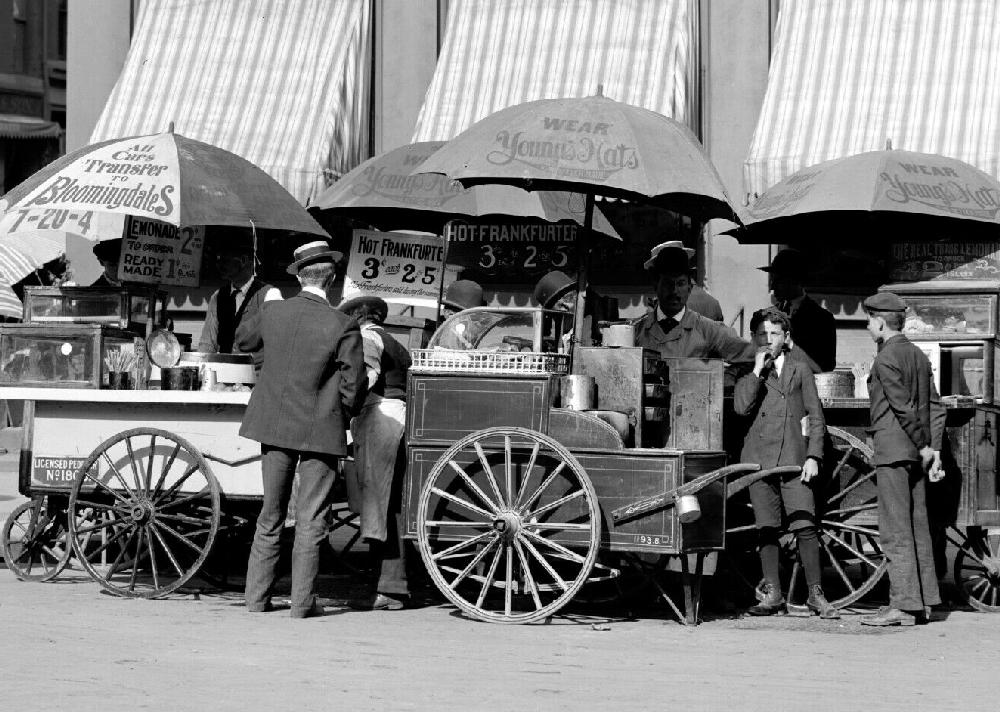
Economics: Inflation

Figure 1.--Here we see an easily calcuable example of inflation. New Yorkers could by a hot dog/frankfurter for 3 cents in 1906. The price for a hot dog in 2019 (away from the tourist areas appears to be about $2.00-3.00 or about 830 percent/7.8 percent annually. The United States has had some periods of high inflation during the 20 century, but the currency ha been more stable than most countries and except for the Revolutionary War has never expeienced hyperinflation. On average the inflation rate since 1900 comes out to about 3 percent. The higher New York hot dog rate proably relects the huge cost of licensing and fees. | |
Inflation is the level of increase in the prices for goods and services. When prices rise money buys fewer goods and services. A a result, inflation reflects a reduction in purchasing power. This means that the real value of the currency declines. Iflation has been an issue ever since civilized society were forced to move away from barter abd create currency, at first primarily metal coins. At the time not only prices affected infkation, but a debasement of the coins, government officials reducing the silver and gold content. Once paper currency was introduced the question of the metalic backing was important, but after Government stopped exchaning currebcy for gold or silver thus has become of much less importance. Today the inflation rate reflects both prices and the amount of currency issued. Countrieslike Zimbabwe and Venezueal which simply turn on the printing presses essentually destroy the value of their currency. The measure of the level of inflation over time is the inflation rate. There is no way of course of measuring all financial transacrions. As a result, governments create baskets of good and sevices that can be measued to relect the overall. the annualized percentage change in a general price index, usually the consumer price index, over time. The opposite of inflation is deflation. Inflation affects economies in a varity of ways. mostly negative, but some postive. Negative impacts include: 1) the lost opportunity cost of holding money, 2) uncertainty over the future inflation rate, 3) discouraging investment and savings, and 3) shortages of goods abecaue of the erosion of currency value. Positive impacts of modest inflation include: 1) reducing unemployment due to nominal wage rigidity, 2) provising central bank leeway in conducting monetary policy, 3) encouraging loans and investment, and 4) avoiding the problemd associated with deflation. Most economists contend that high inflation rates are primarily caused by an excessive growth of the money supply such as just yurming on the presses. Economists differ Views on which factors determine inflation rates are more varied. Contributing factors can incluse: 1) changes demand for goods and services and 2) changes in supply such as during scarcities. There is a strong consensus among economits that sustained inflation is caused by government increasing the money supply growing faster than the supply creation (economic growth). Modern economists generally favor a low and steady rate of inflation. After years of fighting inflation, mny cebtral bankers in the 2010s have been atempting to create inflation. Limited inflation is believed to reduce the severity recessions by allowing the labor market to adjust more quickly to an economic downturn. Yhe advocates of Modern Monetary Theory coceptualizes currency as a public monopoly and ignores the delerious impacts of defecit bspending and inflation.
CIH

Navigate the Children in History Website:
[Return to the Main Economics page]
[About Us]
[Introduction][Biographies][Chronology][Climatology][Clothing][Disease and Health][Economics][Freedom][Geography][History][Human Nature][Law]
[Nationalism][Presidents][Religion][Royalty][Science][Social Class]
[Bibliographies][Contributions][FAQs][Glossaries][Images][Links][Registration][Tools]
[Children in History Home]
Created: 2:15 AM 7/26/2019
Last updated: 2:15 AM 7/26/2019



